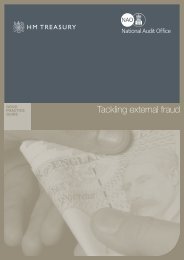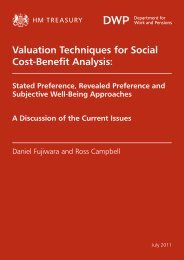4. First case study – the subdivision of the light - HM Treasury
4. First case study – the subdivision of the light - HM Treasury
4. First case study – the subdivision of the light - HM Treasury
You also want an ePaper? Increase the reach of your titles
YUMPU automatically turns print PDFs into web optimized ePapers that Google loves.
F05 Ch4 Subdivision <strong>of</strong> <strong>the</strong> <strong>light</strong>.doc<br />
05/04/2006 19:34:00<br />
Technological roulette <strong>–</strong> a multi-disciplinary <strong>study</strong> <strong>of</strong> <strong>the</strong> dynamics <strong>of</strong> innovation in electrical, electronic<br />
and communications engineering.<br />
<strong>4.</strong> <strong>First</strong> <strong>case</strong> <strong>study</strong> <strong>–</strong> <strong>the</strong> <strong>subdivision</strong> <strong>of</strong> <strong>the</strong> <strong>light</strong><br />
Lamps <strong>of</strong> this type took at least a minute to reach operating conditions and, under<br />
critical conditions, were provided with one or more carbon filament lamps which were<br />
coupled to <strong>the</strong> heating coil circuit and extinguished when <strong>the</strong> solenoid operated.<br />
The Nernst lamp was manufactured in ratings <strong>of</strong> 16 to 250 candles. It was<br />
positioned between <strong>the</strong> arc lamp and <strong>the</strong> ordinary incandescent lamp and could perform<br />
certain <strong>light</strong>ing tasks more effectively than ei<strong>the</strong>r. Its efficiency advantage over carbon<br />
lamps led to a fairly wide take-up, both in Europe and <strong>the</strong> United States. When <strong>the</strong><br />
Nernst lamp was first introduced and promoted, central-station operators were uneasy<br />
about <strong>the</strong> effect <strong>of</strong> its greater efficiency on <strong>the</strong>ir revenues. They feared that <strong>the</strong>ir<br />
customers would simply substitute Nernst lamps for carbon lamps completely and that<br />
<strong>the</strong> sale <strong>of</strong> energy would decline. In practice this did not happen because <strong>the</strong> Nernst<br />
lamp could not satisfactorily replace all carbon lamps, and, in those applications in<br />
which it could, users took advantage <strong>of</strong> its greater efficiency and economy to provide<br />
higher levels <strong>of</strong> illumination ra<strong>the</strong>r than to reduce <strong>light</strong>ing expenditure. By 1912,<br />
however, <strong>the</strong> ductile tungsten filament lamp gave fur<strong>the</strong>r improvements in efficiency for<br />
general <strong>light</strong>ing purposes and <strong>the</strong> Nernst lamp was, in turn, superseded, although it was<br />
still in use as late as 1926 for specialist applications such as a powerful point <strong>light</strong><br />
source for instrumentation.<br />
Fürst 1926<br />
Nernst applied for German, British, and o<strong>the</strong>r patents on his invention in 1897,<br />
and patents on a number <strong>of</strong> improvements issued in 1899. He withdrew from active<br />
participation in <strong>the</strong> final development and commercialisation <strong>of</strong> his invention and sold<br />
<strong>the</strong> patents to Allgemeine Elektrizitäts Gesellschaft. AEG retained for itself sole selling<br />
rights for Germany and some o<strong>the</strong>r European countries, but disposed <strong>of</strong> <strong>the</strong> patents<br />
elsewhere. George Westinghouse obtained <strong>the</strong> rights for <strong>the</strong> United States and Canada<br />
and set up <strong>the</strong> Nernst Lamp Company to make <strong>the</strong> new lamp. This was <strong>the</strong> only major<br />
new incandescent lamp introduced in <strong>the</strong> United States between 1897 and 1912 that was<br />
not controlled by General Electric. Ganz & Company secured <strong>the</strong> rights for Austria,<br />
Hungary, and Italy. The Nernst Electric Light Company, Ltd., was formed in England to<br />
acquire <strong>the</strong> rights for Australia, Africa, Asia, South America, and Central America,<br />
whilst <strong>the</strong> rights for Britain itself were sold to GEC. The validity <strong>of</strong> <strong>the</strong> Nernst patents<br />
77





![AIRTO [Professor Dr Brian Blunden] - HM Treasury](https://img.yumpu.com/15492848/1/184x260/airto-professor-dr-brian-blunden-hm-treasury.jpg?quality=85)










